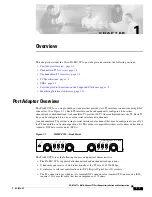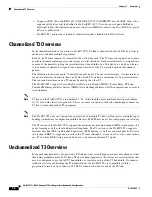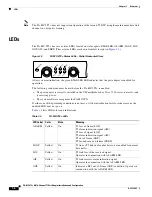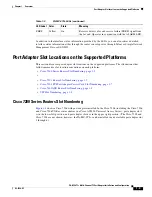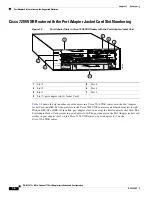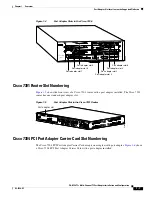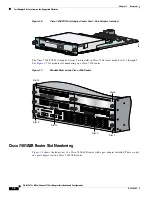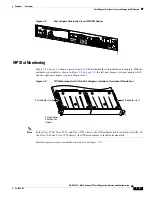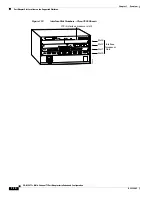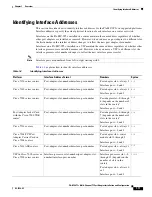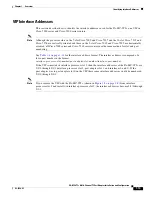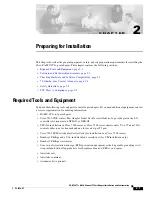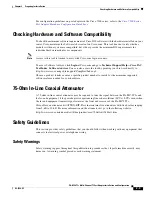
1-2
PA-MC-2T3+ Multi-Channel T3 Port Adapter Installation and Configuration
OL-3526-05
Chapter 1 Overview
Channelized T3 Overview
•
It supports RFC 1406 and RFC 1407 (CISCO-RFC-1407-CAPABILITY.my). For RFC 1406, Cisco
supports all tables except the FarEnd table. For RFC 1407, Cisco does not support FarEnd or
Fractional tables. (For information on accessing Cisco MIB files, refer to the
Cisco MIB User Quick
Reference
publication.)
•
PA-MC-2T3+ microcode is loaded at initialization and is bundled into IOS software.
Channelized T3 Overview
In the channelized mode of operation, a PA-MC-2T3+ T3 link is channelized into 28 DS1 data lines in
an industry standard multiplexing format.
Each of the T1 lines contains 24 timeslots of 64 or 56 kbps each. The T1 lines can support one or more
user data channels which appear to the system as serial interfaces. Each serial interface is assigned one
or more of the timeslots giving the serial interface a bandwidth of n x 56 kbps or n x 64 kbps, where n
is the number of timeslots assigned. Any unused timeslots of the T1 are filled with an idle channel
pattern.
The following restrictions apply: A timeslot can only be used by one serial interface. A serial interface
cannot use timeslots from more than one T1 line. Each T3 can have a maximum of 128 serial interfaces.
Unused serial interfaces on one T3 cannot be used by the other T3.
The PA-MC-2T3+ supports Cisco High-Level Data Link Control (HDLC), Frame Relay, PPP, and
Switched Multimegabit Data Service (SMDS) Data Exchange Interface (DXI) encapsulations over each
serial interface.
Note
T1 lines on the PA-MC-2T3+ are numbered 1–28, rather than the more traditional zero-based scheme
(0–27) used with other Cisco products. This is to ensure consistency with telco numbering schemes for
T1 lines within channelized T3 equipment.
Note
The PA-MC-2T3+ does not support the aggregation of multiple T1 lines (called inverse multiplexing or
bonding) in hardware for higher bandwidth data rates. MLPPP may be used for this purpose in software.
The T3 section of the PA-MC-2T3+ supports the maintenance data-link channel (MDL) when using c-bit
parity framing as well as local and network loopbacks. The T1 section of the PA-MC-2T3+ supports
facilities data link (FDL) in Extended Superframe (ESF) framing, as well as various loopbacks. Bit error
rate testing (BERT) is supported on each of the T1 lines although a test may not be active on more than
one T1 at a time. BER testing may be done over a framed or unframed T1 signal.
Unchannelized T3 Overview
In the unchannelized mode of operation, a T3 link provides a single high speed user data channel, rather
than being multiplexed into 28 T1 lines. The data channel appears to the system as a serial interface that
may be configured to use the full T3 bandwidth or a smaller portion of the T3 bandwidth. No industry
standard exists for subdividing the T3 bandwidth but the PA-MC-2T3+ is compatible with the
proprietary formats of five vendors of T3 DSUs, when used at the far end of the T3 link.














